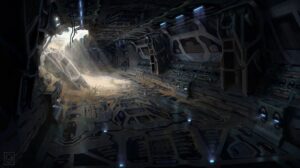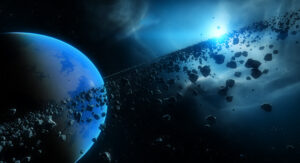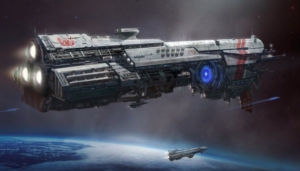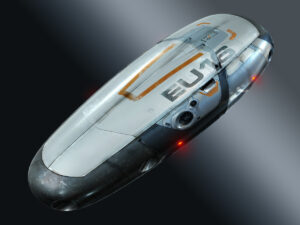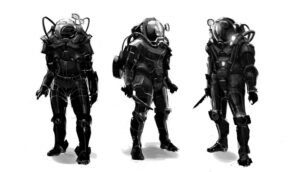IY6026.153
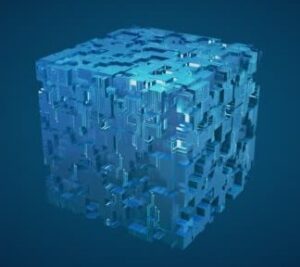 SAFCO and associates start where they left off, on a blasted planet several parsecs into the Void. The away team of Flint, Lucky, Zal, Fardt, and the Baroness are at the ruined alien installation they discovered last session, on the edge of an impact crater. They are outside the entrance to the corridor they had only begun to explore, looking at the disabled air-raft that was shot by an alien robotic drone’s laser. Flint, having air-raft skill, examines the vehicle and finds a laser shot has gone right through the power source. The vehicle might be repairable. Lucky and Flint examine the wreckage of the drone, finding somewhat high tech level electronics and technology, but incompatible with their own systems for various reasons.
SAFCO and associates start where they left off, on a blasted planet several parsecs into the Void. The away team of Flint, Lucky, Zal, Fardt, and the Baroness are at the ruined alien installation they discovered last session, on the edge of an impact crater. They are outside the entrance to the corridor they had only begun to explore, looking at the disabled air-raft that was shot by an alien robotic drone’s laser. Flint, having air-raft skill, examines the vehicle and finds a laser shot has gone right through the power source. The vehicle might be repairable. Lucky and Flint examine the wreckage of the drone, finding somewhat high tech level electronics and technology, but incompatible with their own systems for various reasons.
Back on the ship, Barney has repaired minor electrical damage done by Joe’s jury-rigging of an external sensor array to give them some vision outside the rocky overhang currently sheltering the ship. Joe and Roger alert the away team that one of the two large objects that were descending from space appears to be landing very near the alien installation. The away team spots it, high above their position and slightly back toward the ship, Flint using his rifle scope and Fwd Observer skill to estimate its size. Looks to be about the same size as the ones encountered in space — about the same volume as their ship.. Joe keeps watch for any drones that might approach the ship’s location.
Back with the away team, the group shelters in the first few feet of the damaged corridor in the side of the crater wall. Flint stays outside and attempts to use his Forward Observer skill to tell where the thing is going to land, but it land back over the crater wall — obscuring his view. Still based on his last sighting, he estimates it has landeded between 1/4 and 1/2 a mile away, which would put it back in the woods. He grabs some supplies (including a grenade launcher and some grenades) and stealthily climbs the up to the top, and proceeds out to find the cube.
Lucky and Fardt cover the air-raft with brush to camouflage it from the air. They then move back into the corridor. Inside the corridor, Lucky feels someone tap him on the shoulder. It’s Fardt, who then points down the dark corridor to the Baroness, who is moving past some rubble, further down the hall. Lucky calls out to her, but she doesn’t answer. Eventually he hears her exclaim “amazing.” The group follows her, dodging patches of glowing green slime, emerging into a larger and rubble-strewn chamber.
The crew at the ship decides on a course of action. Joe has spotted one of the smaller 4′ cube drones moving over the canopy of trees, some distance away. It must be destroyed. They decide that Art, the newest member of SAFCO, will use his Grav-Vehicle skill to take the mining pod and attempt to destroy that drone before it finds the ship. The pod is quick and maneuverable, has 2 grasping arms, one of which includes a mining laser usable at short range for 5d6 damage. He’ll have to get in close. Joe moves out in the forest, finds a line of site to the cube drone, and fires at it at extreme long range to distract it. It takes notices and begins moving toward him and away from the ship. Art takes off in the mining pod, quickly seeing it in the distance.
Using his Forward Observer skill, Flint creeps through the woods and finds the larger cube landed in a clearing. It is quiet. He waits and watches, debating further action and conferring with the team via communicator.
Art makes his Grav-Vehicle skill roll and is able to execute a fancy evasive maneuver that allows him to get to close range on the cube drone without it noticing. However, when he finally gets in laser range, the cube makes it’s target roll. It twirls about in mid-air, the muzzle of its laser cannon facing the mining pod. Simultaneous action — the mining pod hits it doing enough damage to severely disable it, while the cube misses the quickly darting pod. The cube is wobbling in the air.
The Rambler-II has meanwhile taken to the air to assist the pod. Roger makes an absurdly high Pilot roll and performs some crazy evasive maneuvers in case anything decides to shoot at them. Barney is in the top dual laser turret, and trains the sites on the cube. However, the pod and the cube are very close together. A miss might result and the loss of the pod and the loss of good navigator. Barney decides not to fire. Art fires the mining pod’s laser again, destroying the cube.
Hearing all this on the radio, and knowing that Lucky is having trouble keeping the Baroness and Zal under control, Flint starts back toward the installation. The mother cube is just sitting there.
Inside the alien installation, the away team discovers a large chamber with 3 large vats. the vat’s all have a pipe running into the north way, and each has a pipe running south, converging with the other two, and leading down another passageway.
Roger and Barney decide, for the meantime, to return the ship to its shelter. Art follows them in the mining pod, and they meet back up with Joe.
As Flint makes his way back to the installation, the away team continues to explore the facility. Like the entryway, there are patches of glowing green slime on the floor and walls, and the dust of dead slime all over. The Baroness discovers a thick glass window on the far side of the chamber, and uses a rag to clean it off enough to shine a light inside. She tells the team it looks like some sort of control room, but there is no obvious entrance. Lucky and Fardt explore the rest of the chamber, finding another corridor that was obscured by rubble. Fardt goes in and reports that there is a lot of rubble inside, and some slime, but it is passable. Lucky follows him and goes further, finding that he corridor moves diagonally and left, and there are a number of doors and openings down there. The team discusses what to do next.
End of Session
IY6026.153
Elapsed game time: 217 days
